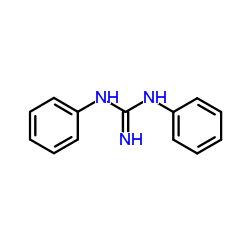1,3-Diphenylguanidine

1,3-Diphenylguanidine structure
|
Common Name | 1,3-Diphenylguanidine | ||
|---|---|---|---|---|
| CAS Number | 102-06-7 | Molecular Weight | 211.262 | |
| Density | 1.1±0.1 g/cm3 | Boiling Point | 321.3±25.0 °C at 760 mmHg | |
| Molecular Formula | C13H13N3 | Melting Point | 146-148 °C(lit.) | |
| MSDS | Chinese USA | Flash Point | 148.1±23.2 °C | |
| Symbol |



GHS06, GHS08, GHS09 |
Signal Word | Danger | |
|
Occupational allergic contact dermatitis and patch test results of leather workers at two Indonesian tanneries.
Contact Dermatitis 67(5) , 277-83, (2012) Tannery workers are at considerable risk of developing occupational contact dermatitis. Occupational skin diseases in tannery workers in newly industrialized countries have been reported, but neither the prevalence of occupational allergic contact dermatitis ... |
|
|
Allergic contact dermatitis to synthetic rubber gloves: changing trends in patch test reactions to accelerators.
Arch. Dermatol. 146(9) , 1001-7, (2010) Rubber gloves are one of the most frequent causes of occupational allergic contact dermatitis, especially in health care workers.We describe 23 patients with allergic contact dermatitis due to rubber accelerators in rubber gloves, some with disseminated derma... |
|
|
Identification of unexpected modifications of fluorescein-labeled oligodeoxynucleotides by nuclease P1 digestion and mass spectrometric techniques.
Rapid Commun. Mass Spectrom. 14(1) , 26-32, (2000) Fluorescein-labeled oligodeoxynucleotides (ODNs) from automated synthesis commonly produce multiple peaks in high performance liquid chromatography (HPLC) chromatograms. We found that these peaks are due to chemical modifications of the ODNs instead of the co... |
|
|
Occupational allergic contact dermatitis caused by sterile non-latex protective gloves: clinical investigation and chemical analyses.
Contact Dermatitis 68(2) , 103-10, (2013) An increased frequency of occupational contact hand dermatitis among surgical operating theatre personnel has been noticed.To evaluate patients with occupational contact dermatitis caused by their rubber gloves, and to describe a method for analysing the cont... |
|
|
Identification of an unknown extraneous contaminant in pharmaceutical product analysis.
J. Pharm. Biomed. Anal. 45(5) , 747-55, (2007) During the content uniformity test of a drug product (tablet formulation), an unknown peak was observed in the HPLC chromatograms. Upon further investigation, it was determined that the unknown peak was originated from an external source and, therefore, the d... |
|
|
In vitro oxygenation of N,N'-diphenylguanidines.
Xenobiotica 23(2) , 155-67, (1993) 1. The enzymic C-oxygenation of N,N'-diphenylguanidine (DPG) to N-(4-hydroxyphenyl)-N'-phenylguanidine (4HPG) and the N-oxygenation of N,N'-bis-(pentafluorophenyl)-guanidine (BPG) to N"-hydroxy-N,N"-bis-(pentafluorophenyl)-guanidine (HBPG) is reported. 2. The... |
|
|
Diagnostic pearls in occupational dermatology.
Dermatol. Clin. 12(3) , 485-9, (1994) The author presents four cases in which investigation has led to new knowledge of causes and new diagnostic tools for occupational dermatoses. |
|
|
Body fluid analysis of 1,3-diphenylguanidine for mutagenicity as detected by Salmonella strains.
J. Environ. Pathol. Toxicol. Oncol. 6(2) , 293-301, (1985) The toxicity and mutagenicity of 1,3-diphenylguanidine (DPG) were monitored in Salmonella bacteria using the direct incorporation protocol. The test consisted of either direct incorporation of DPG or analysis of body fluid and faecal material derived from ani... |
|
|
Allergic reaction to nonrubber products by testing with rubber mixes. Part IV: the carba mix.
Cutis. 56(6) , 314, (1995)
|
|
|
Lymphomatoid allergic contact dermatitis mimicking cutaneous T cell lymphoma.
Dermatitis 21(4) , 220, (2010)
|